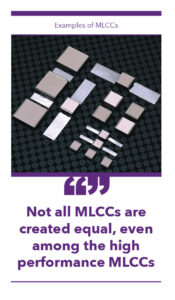Johanson Technology’s vice president, Scott Horton, explains how domestic MLCC manufacturers are ramping capacity to fulfill orders for large format, high Q ceramic capacitors.
 Industrial, medical and military demand for high quality, high-voltage,
Industrial, medical and military demand for high quality, high-voltage,
multi-layer ceramic capacitors (MLCCs) has been hit hard by the insatiable requirement for smaller, lower voltage—and in some way—lower performance MLCCs fueled by 5G networks, smart phones and mobile devices. OEMs are experiencing delays up to six months, jeopardizing product release schedules, industrial market share and potentially even military readiness.
Due to a slowdown in capacitor demand in 2019, many OEMs and distributors were left holding surplus inventory and were hesitant to order inventory in 2020. As the market ramps up, so does MLCC demand despite low capacitor inventory. This further exacerbates shortages of larger high voltage, high Q MLCCs, since some manufacturers have focused production on smaller/lower voltage devices.
Johanson Technology vice president, Scott Horton, said: “There is a ripple effect to the industrial and military market sector that is not really fully understood. Although a shortage of electronic products used to manufacture smartphones and automobiles would be national news, the lack of larger, higher voltage MLCCs for industrial and military applications are typically under-reported.
However, it will continue to squeeze business customers and eventually end users.”
Industrial, medical and military consumers of MLCCs depend on high voltage and high-Q capacitors for power supplies, amplifiers, MRI coils, plasma generators, lasers and many other specialized applications.
In higher current circuits, higher-Q MLCCs are preferred to reduce self-heating.
The Q factor represents the efficiency of a capacitor’s rate of energy loss. High Q capacitors lose less energy reducing the need to dissipate or cool the heat which protects the board from damage and performance loss in sensitive applications.
Not all MLCCs are created equal, even among the high performance MLCCs, yet ensuring a consistent level of performance is critical for the high reliability applications required by industrial and military end users.
Horton explained: “If an MLCC manufacturer is not tightly controlling the layer count, they might be providing 10-layer batches in one batch and then later deliver 17-layer parts in a subsequent batch. These two parts will not perform the same at high frequencies.”
Domestic sources of MLCCs for industrial and military applications have been ramping up capacity. Increased domestic MLCC supply means industrial or military customers need not delay a product’s build or shipment.
Drawing on its focus on high-Q and high voltage MLCCs, Johanson, for example, has expanded its capacity to fill some of the supply void caused by the market’s shift to smaller capacitors.
Horton added: “We’ve been investing in expanding our capacity for several years now through a modernization of our production facility and the opening of a second production line that will essentially double our MLCC output. We can take that even higher with more production shifts.”
At the time of writing, Johanson is quoting large size high voltage MLCC order fulfillment times at 10-weeks.
Horton concluded: “There’s just no reason to move away from ceramic for your high-voltage, high quality applications. There is now a growing domestic MLCC supply available to meet our domestic needs.”
www.johansontechnology.com
